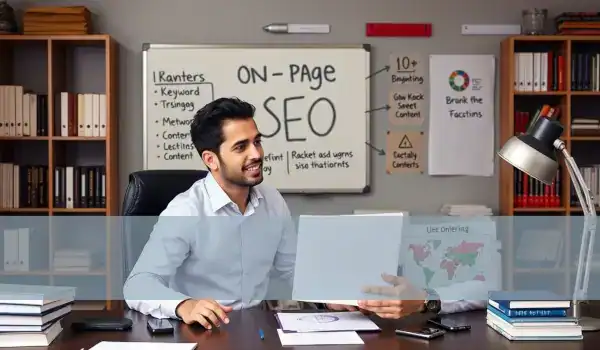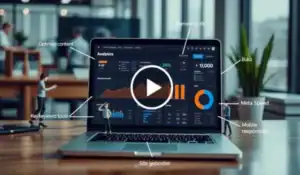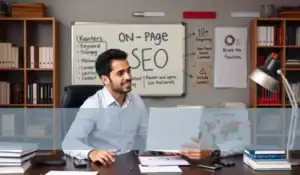On-Page SEO, or On-Site SEO, refers to all the tweaks and strategies you use directly on your website pages to help them rank better in search engines like Google. It’s like dressing your webpage for success, you make it attractive, informative, and easy for users and search engines to understand.
Think of On-Page SEO as your home’s interior. It’s all the decor, furniture, and layout. Meanwhile, Off-Page SEO is like your reputation in the neighborhood, backlinks, reviews, and social signals. Both are crucial, but your house has to be in order first.
Why On-Page SEO Matters for Website Success?
1. Higher Rankings: Search engines love pages that are well-structured, fast, and relevant. By optimizing your pages, you make it easier for search bots to crawl and understand your content, which leads to better rankings.
2. More Organic Traffic: Let’s face it — higher rankings mean more visibility. When your site appears in the top results, people click on it. And the best part? It’s free traffic!
3. Better User Experience: A clean, fast, and well-organized page isn’t just good for Google — it’s great for your visitors too. Happy visitors stay longer, explore more, and eventually become customers.
Key Elements of Effective On-Page SEO
Start by understanding what your audience is searching for. Use tools like Google Keyword Planner, Ubersuggest, or SEMrush to find high-volume, low-competition keywords related to your topic. Smart Keyword Placement: Once you’ve found your target keyword (e.g., Digital Marketing Course in Delhi), place it in:
- Page Title
- Meta Description
- URL
- Headings (H1, H2)
- Image Alt Text
- The first 100 words of your content
- Just remember — keep it natural. No keyword stuffing!
- Title Tags and Meta Descriptions
Writing Compelling Titles
Your title tag is the first thing users and Google see. Make it catchy, clear, and include your main keyword.
Example:
- “Best Digital Marketing Course in Delhi | Enroll Today!”
- Crafting Click-Worthy Descriptions
- Your meta description should act like an ad. Summarize the page in 150–160 characters and include the keyword.
URL Structure
- Clean and SEO-Friendly URLs
- Short, readable URLs work best. Avoid numbers and random strings.
Example:
- Yourwebsite.com/digital-marketing-course-delhi
- Yourwebsite.com/page?id=1234
- Header Tags (H1, H2, H3…)
Why Proper Heading Structure Matters?
Headings break up your content and help readers scan easily. Plus, Google uses them to understand your page structure.
- H1 – Main page title (use once)
- H2 – Subsections
- H3/H4 – Details under subsections
- High-Quality Content
User Intent and Engagement
Don’t just write for keywords — write for people. Understand their questions and answer them in a helpful, engaging way. Use analogies, visuals, and examples to make your content relatable.
Image Optimization
- Alt Text and Compression Techniques
- Images should enhance the page, not slow it down.
- Compress images before uploading
- Add relevant alt text for SEO and accessibility
Example Alt Text:
- “Students attending a digital marketing class in Delhi”
- Internal Linking
Building a Logical Site Structure
Link related pages together. This helps users navigate and helps Google crawl your site more effectively.
Example:
If you have a blog post on “SEO Tips for Beginners,” link it from your “SEO Services” page.
- Page Speed Optimization
- Tips to Improve Load Time
- Compress images
Use caching
- Minimize CSS and JavaScript
- Choose a reliable hosting provider
- Mobile-Friendliness
Responsive Design Best Practices
Make sure your site looks and works great on phones and tablets. Use responsive design, larger buttons, and readable text sizes.
Technical HTML Elements for On-Page SEO
1. Schema Markup: Schema helps Google understand the content type, like reviews, events, or FAQs, and display rich snippets in search results.
2. Canonical Tags: These prevent duplicate content issues by telling Google which version of a page to index.
3. Robots.txt and Sitemap: Ensure your robots.txt allows search engines to crawl your important pages, and submit a sitemap to Google Search Console for better indexing.
Best Practices for On-Page SEO
1. Keep Content Fresh and Relevant: Update old posts with new stats, remove outdated info, and republish evergreen content to keep it alive.
2. Write for Humans, Optimize for Search Engines: Focus on value and clarity. Then, sprinkle in your keywords and HTML tags naturally.
3. Balance SEO with User Experience: Don’t chase rankings at the cost of usability. A page that’s hard to read or navigate will drive users away — and hurt your SEO in the long run.
How On-Page SEO Complements Other SEO Tactics?
- Integration with Off-Page and Technical SEO
- A successful SEO strategy covers all bases:
- On-Page: Your content and structure
- Off-Page: Backlinks, PR, social signals
- Technical: Security, speed, mobile performance
- Mastering On-Page SEO gives you a solid foundation to build everything else on.
Conclusion
If you’re serious about driving more traffic to your website, On-Page SEO is non-negotiable. It’s the engine under your site’s hood. When tuned right, it can take you to the top of Google search results. Remember — SEO is a marathon, not a sprint. Keep learning, testing, and optimizing. Your hard work will pay off in more traffic leads, and conversions.
FAQs
How often should I update my on-page SEO?
You should review your content every 3–6 months to ensure keywords, links, and information are still relevant.
Can I do On-Page SEO without technical skills?
Yes! Most of On-Page SEO involves content and structure. Tools like WordPress make it beginner-friendly.
Is keyword density still important?
Not really. Google focuses on context now. Just use keywords naturally where they fit.
Should every page have a unique keyword?
Absolutely. Each page should target a different main keyword to avoid cannibalization.
How do I know if my On-Page SEO is working?
Track your rankings, traffic, bounce rate, and conversions using tools like Google Analytics and Search Console.






